5 Proven Discount Tips to Increase AOV (Up to 40%)
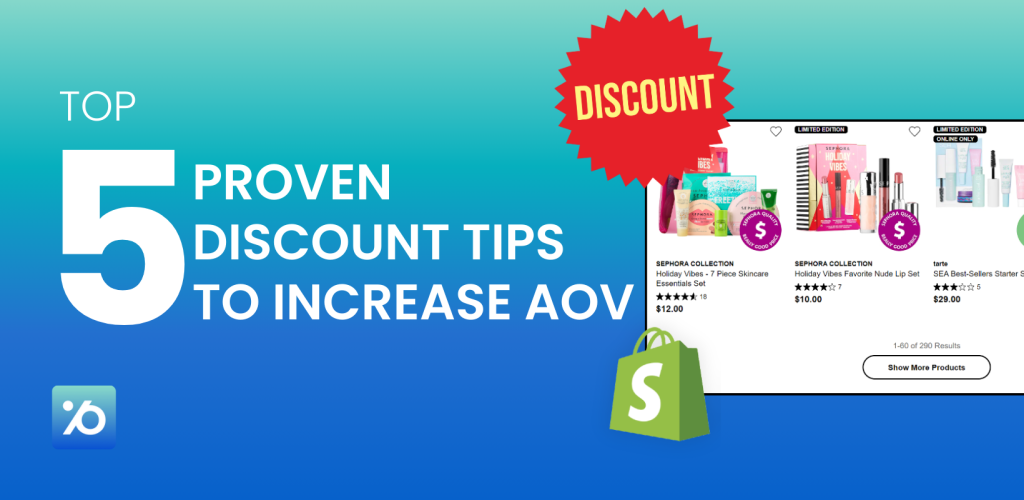
Want to know the difference between stores that struggle and stores that thrive? It often comes down to one key metric: average order value (AOV). While everyone obsesses over getting more traffic, smart merchants focus on making each customer worth more.
Here’s the truth: boosting your AOV by just 10% can transform your business. And the best part? You don’t need complicated strategies or expensive tools. These 5 discount tips have helped countless Shopify stores increase their AOV by up to 40%, and they can work for you too.
Tip 1: Use Round Numbers for Cart Thresholds
Before diving into specific discount pricing strategies, remember that smart discounting isn’t about slashing prices – it’s about strategic psychology that makes customers happy to spend more. Let’s start with something surprisingly simple: the numbers you choose matter more than you think.
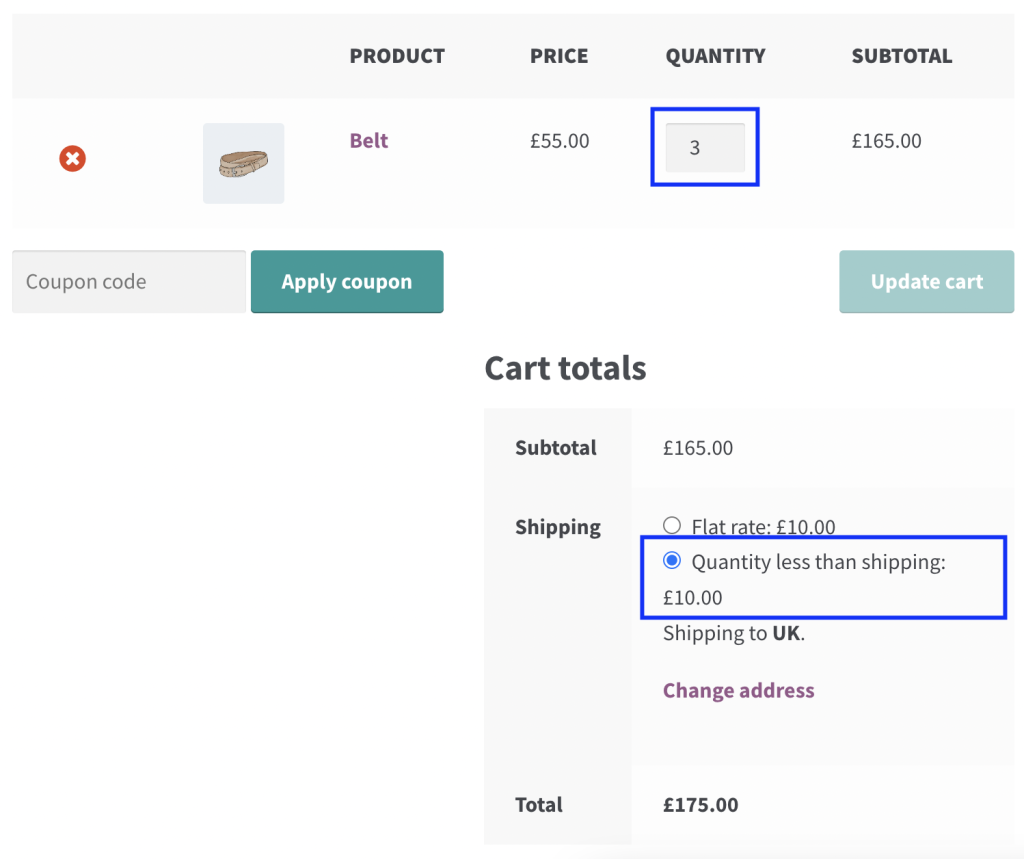
The Insight
When you set a free shipping threshold at $47.99, you’re actually working against yourself. Round numbers like $50 work better because they’re mental milestones that customers naturally want to reach. It’s the difference between a confusing calculation and a clear goal.
Why This Works
Think about it, when you see “Free shipping on orders over $50,” your brain instantly knows what to do. But “$47.99”? That feels arbitrary, maybe even manipulative. Round numbers tap into how we naturally think about money. They’re satisfying to hit, like reaching a nice, even score in a game.
Research backs this up. Customers are more likely to add items to reach $50 than $49, even though it’s just a dollar difference. That’s because $50 feels like an achievement, while $49 feels like a pricing trick.
How to Implement
Look at your current average order value. If it’s $42, set your threshold at $50, a clean number that’s about 20% higher. Then make it impossible to miss:
- Add a banner at the top of every page
- Show progress in the cart (“Just $8 away from free shipping!”)
- Use pop-ups when customers are close
The key? Keep the messaging simple. “Spend $50, get free shipping” beats complicated explanations every time.
Real Results
Major retailers have proven this discount tip works. Target uses $35. Amazon used $35, then $49. They picked these round numbers for a reason, they drive results. One beverage brand increased AOV simply by raising their threshold to a round number. Customers adjusted their behavior almost immediately, adding extra items to hit the mark.
Tip 2: Show Savings in Value, Not Just Percentages
While our first discount tip focused on the psychology of numbers, this next one reveals how presentation matters just as much as the discount itself. Here’s a question: which sounds better, “15% off” or “$50 off”? The answer depends on the price, and getting it right can double your coupon redemptions.
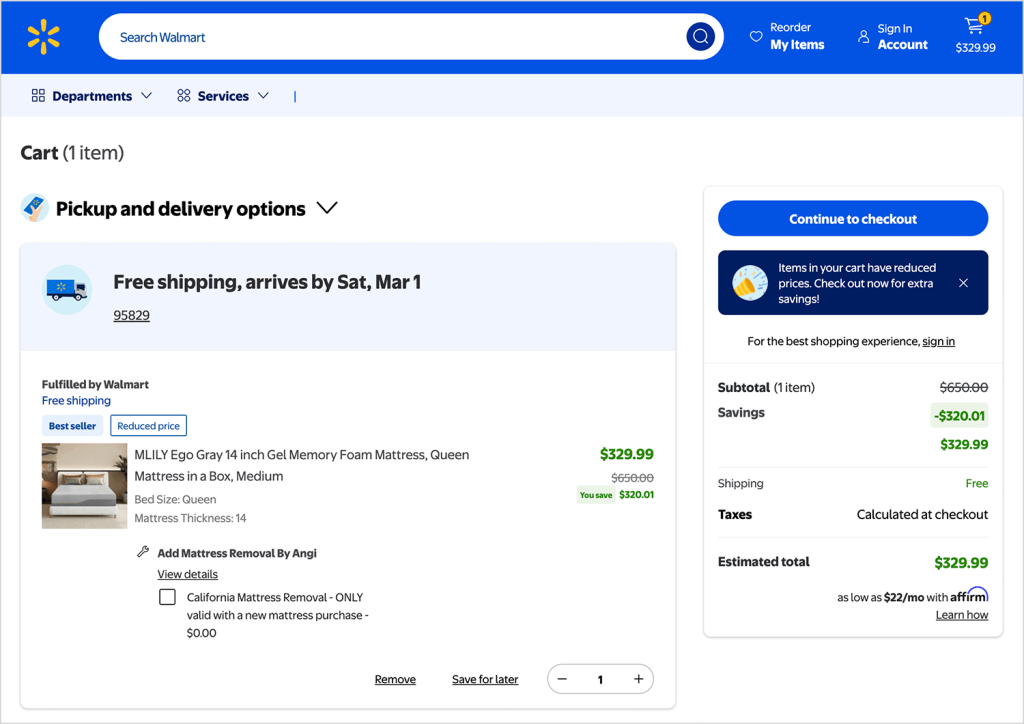
The Psychology Behind It
People don’t walk around with calculators. When they see “15% off,” they have to do math. But “$50 off”? That’s instant understanding.
There’s actually a rule for this: If your product costs under $100, use percentages. Over $100? Use dollar amounts. Why? Because the bigger number wins. On a $30 item, “25% off” sounds better than “$7.50 off.” But on a $300 item, “$50 off” beats “17% off” every time.
When to Use Each Format
- For items under $100: Lead with percentages. That $40 shirt? “25% off” grabs attention better than “$10 off.”
- For items over $100: Show dollar savings. That $250 coat? “$50 off” sounds more impressive than “20% off.”
Pro tip: When possible, show both. “Save $30 (20% off)” covers all bases.
Implementation Example
A furniture store tested this with a $350 couch. They offered two promotions: “$50 off” versus “15% off.” The percentage actually saved customers more ($52.50), but the $50 offer got nearly three times more redemptions. Why? Because 50 is a bigger number than 15, and that’s what people notice first.
Tip 3: Set Thresholds Just Above Your Average Order Value
Among all discount pricing strategies, this one is beautifully simple yet incredibly effective: figure out what customers typically spend, then dangle a carrot just beyond that point.
The Strategic Formula
If your average order is $45, don’t set your free shipping at $100, nobody’s going to more than double their purchase. But $55 or $60? That’s achievable. Many customers will grab one more item to get there.
The formula? Add 20-30% to your current AOV. Round to a clean number (remember Tip 1), and you’ve got your threshold.
Multi-Tier Strategy
Why stop at one threshold? Create a ladder:
- $50: Free shipping
- $75: Free shipping + 10% off
- $100: Free shipping + 15% off + free gift
Each tier gives customers a reason to climb higher. Someone at $70 might think, “Just $5 more for an extra discount? Why not?”
Case Study Results
Eric Carlson, founder of 10xFactory, has experience across different industries and reveals various wins, such as a beverage brand increasing AOV significantly by raising its free shipping minimum. No fancy tactics, they simply moved the goalpost slightly higher, and customers adjusted. In broader studies, over a third of retailers saw meaningful AOV increases after introducing strategic thresholds.
This discount tip alone can transform your business, but when combined with the next strategy, the results multiply.
Tip 4: Create Progressive Reward Ladders
Take the multi-tier concept and turn it into a full strategy. This is the “spend more, save more” approach that major retailers use during every big sale.
The Ladder Psychology
Remember climbing monkey bars as a kid? You’d reach for the next rung because you were so close. Same principle here. When customers see they’re one item away from a bigger discount, they rarely stop.
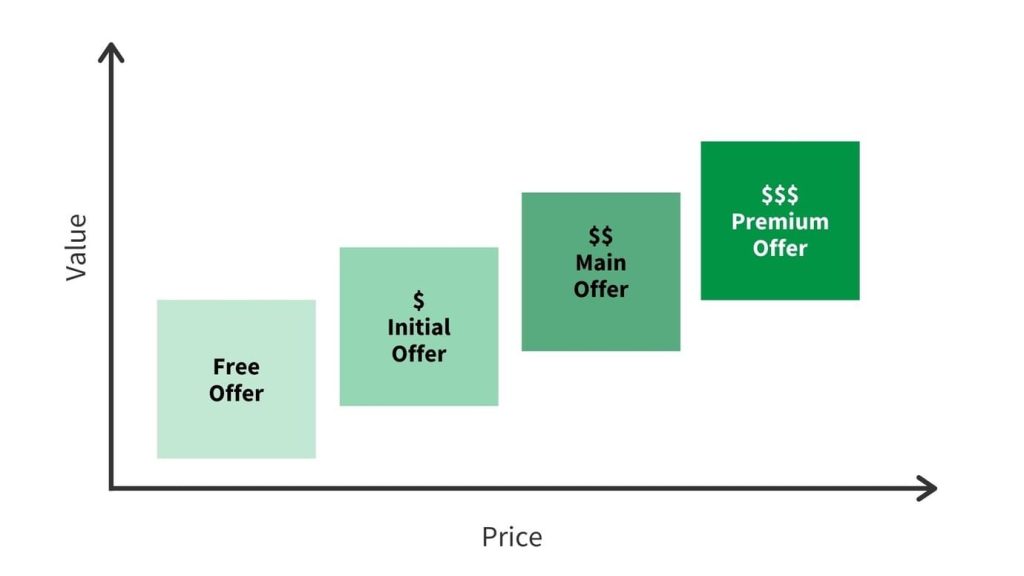
This taps into loss aversion, people hate leaving money on the table. If spending $20 more saves them $30, the math is obvious. But more than that, it feels like winning.
Implementation by Business Type
For example:
- Fashion/Beauty: Use percentage tiers. “Buy 2 items, get 20% off. Buy 3, get 30% off.” Perfect for clearing seasonal inventory.
- Electronics: Dollar amounts work better. “Save $25 on $200+, $75 on $500+.” The savings feel substantial on big-ticket items.
- Food/Supplements: Mix immediate and future rewards. “Spend $50 for free shipping, $75 for a free sample, $100 for 10% off your next order.”
To know which option suits you best, you must understand your industry and conduct repeated tests. That’s the secret to success!
Performance Data
Unlike traditional discount pricing strategies that focus on markdowns, progressive ladders actually increase perceived value while boosting your margins. One marketer shared a Cyber Week strategy: “10% off $49+, 20% off $99+, 30% off $199+.” The result? AOV “blew up.” That’s not scientific, but it matches what brands consistently report, tiered discounts can increase order values by 20-40% during promotions.
Tip 5: Use Time-Sensitive Bundle Amplifiers
Combine the power of bundling with urgency, and you’ve got a recipe for bigger orders.
Types of Time-Sensitive Amplifiers
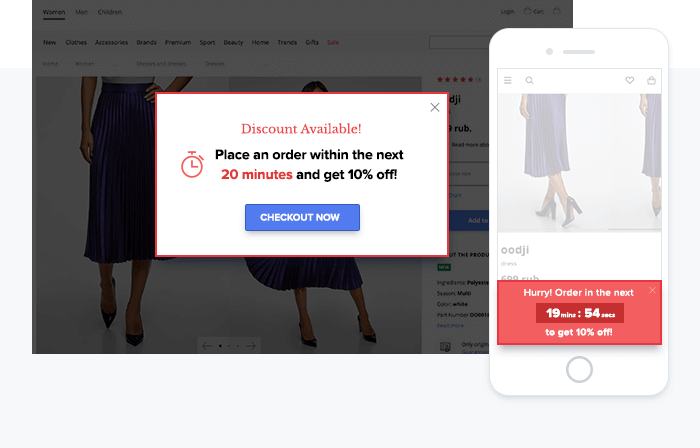
Flash Bundles: “48 hours only: Get our starter kit for 30% off.” The clock creates urgency, the bundle increases order size.
Seasonal Sets: “Winter skincare bundle, this month only.” Natural deadlines that make sense to customers.
Checkout Upsells: “Add the matching accessory for 50% off, offer expires when you leave this page.” Immediate pressure, immediate results.
Implementation Best Practices
Make the deadline crystal clear. Use countdown timers. Send reminder emails. And ensure the bundle actually makes sense, random products thrown together won’t sell, no matter the discount.
Show the value explicitly: “Usually $120, get all three for $79 today only.” Customers need to see exactly what they’re saving.
Successful Campaign Example
An electronics retailer ran a 3-day bundle promotion: phone + headphones + charger at a package price. Sales increased 30% during those three days. A beauty brand’s limited-time skincare set drove 50% more traffic and a surge in new customers. The combination of urgency and value creates a powerful motivator.
How To Make These Discount Strategies Actually Work?
Here’s what nobody talks about when sharing discount tips: implementation is where most stores fail. You’ve just learned five powerful strategies to boost AOV. You’re excited. You open Shopify’s admin panel, ready to set up that brilliant tiered discount system. Then reality hits.
You want to offer “Buy 2, get 10% off. Buy 3, get 20% off. Buy 5+, get 30% off” on your bestselling collection. Simple enough, right?
Wrong.
In Shopify’s native system, you’d need to create multiple discount codes. Customers have to remember which code to use. Your checkout becomes a guessing game. Half your customers miss out on the better deals because they don’t know they exist.
Or worse, you want different tiers for different customer groups. VIPs get better rates. New customers get starter incentives. Wholesale buyers have their own structure. Suddenly, you’re drowning in spreadsheets, codes, and angry customers asking why their discount didn’t work.
Then there’s testing. You want to see if a 15% discount at $75 performs better than 20% at $100. In the native system? You’d have to manually track everything, pause campaigns, create new ones, and pray you don’t mess up the transition.
How Smart Stores Solve This Problem
This is where modern discount pricing strategies meet technology – Pareto: Quantity Breaks & Discounts.
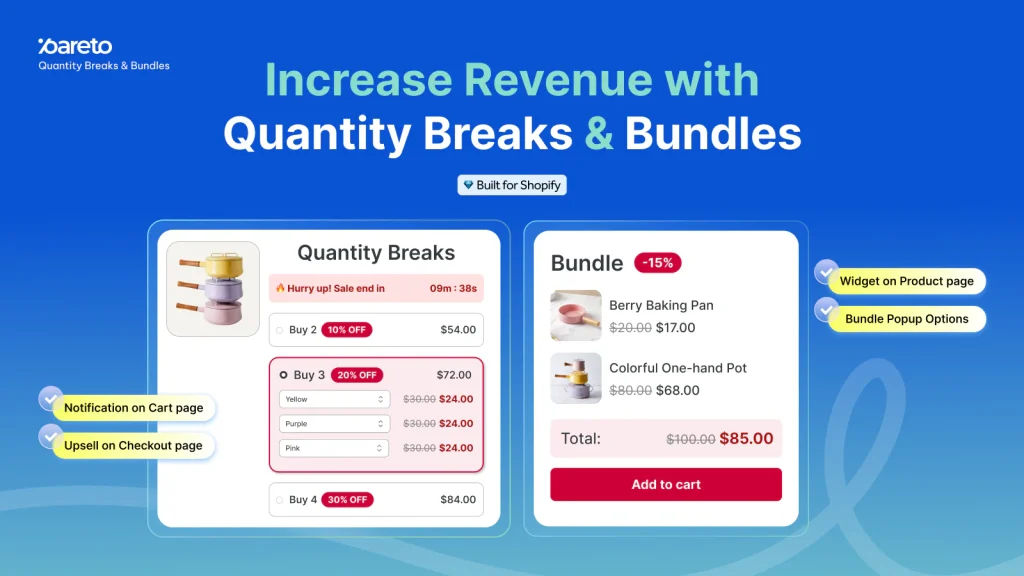
Instead of juggling multiple codes and confusing customers, Pareto automatically applies the right discount as shoppers add items to their cart. They see exactly what they’re saving and what they could save with just one more item. No codes to remember. No confusion at checkout. Here’s what actually happens:
- A customer adds 2 shirts to their cart
- They instantly see “You’re saving 10%! Add one more for 20% off”
- The discount applies automatically, no code needed
- Your AOV jumps right on the app’s statistics page
Here’s why Pareto actually helps you apply the discount tips we mentioned earlier:
- Use Round Numbers for Cart Thresholds – Pareto lets you create cart-value-based offers so your thresholds feel clean and achievable (e.g., $50, $75, $100).
- Show Savings in Value, Not Just Percentages – Flexible discount types let you show fixed amounts per product, across all items, or on the lowest-priced items. Shoppers immediately understand the value.
- Set Thresholds Just Above Your Average Order Value – The app’s statistics page tracks your AOV monthly, making it easy to optimize your thresholds for maximum impact.
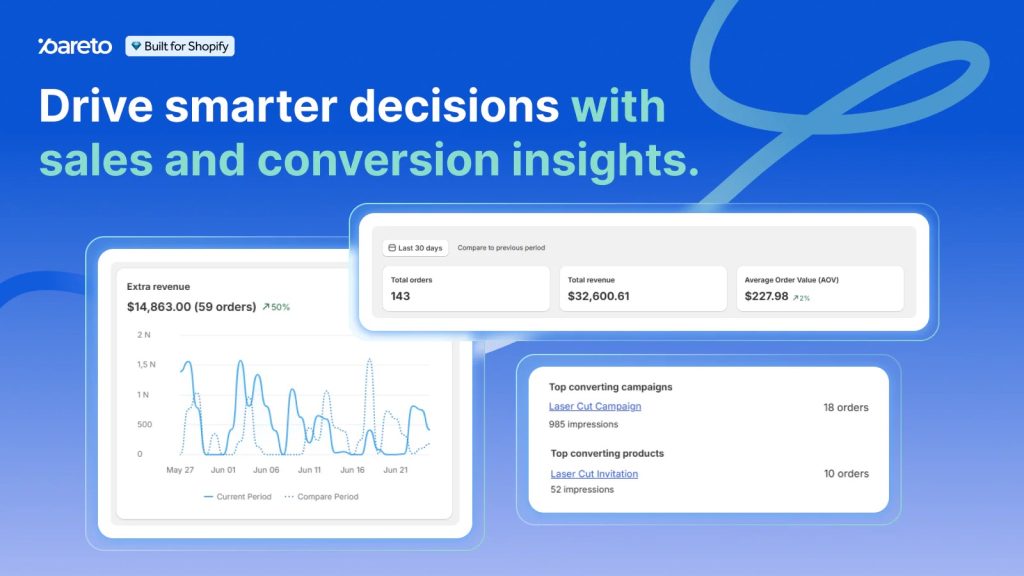
- Create Progressive Reward Ladders – You can set up tiered discounts for each cart value, so every additional item adds more reward, motivating shoppers to buy more.
- Add Urgency with Countdown Timers – Display campaign timers in-cart or as a big banner when shoppers enter your store, nudging them to act fast.
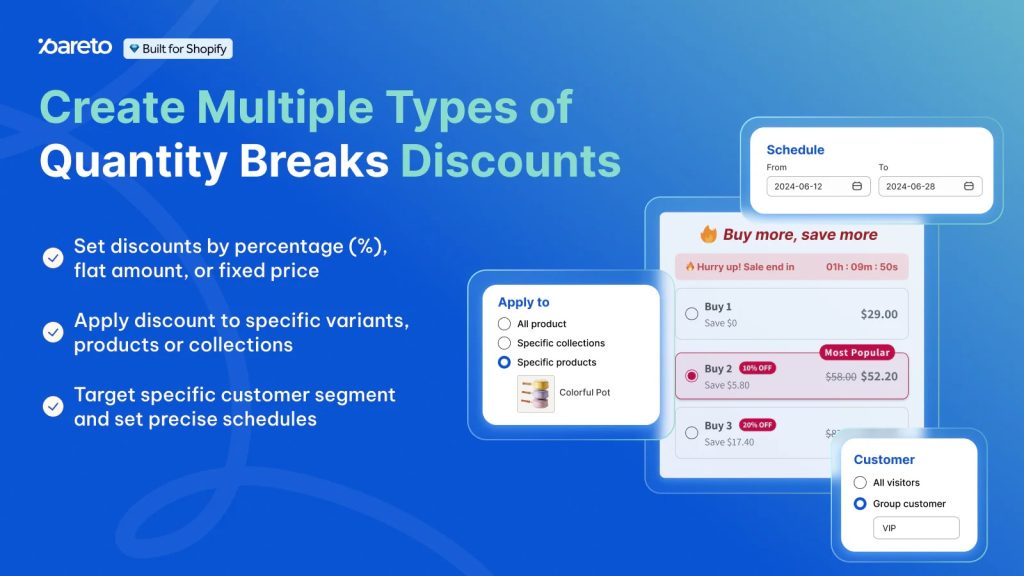
Forget the technical jargon. Here’s what you’ll actually use:
- Set once, run forever – Create your entire tier structure with percentages, fixed amounts, or BOGO deals. Pareto handles the rest automatically.
- Targeted deals for every customer type – VIPs see VIP pricing, first-timers get welcome deals, wholesale buyers get bulk rates. No extra work once set.
- Test instantly – Want to try different thresholds? Change them in seconds. See results immediately. No developer needed.
- Apply anywhere – Discounts can apply to specific products, collections, or your entire store. Combine quantity breaks with free shipping thresholds, and stack benefits without conflicts.
It’s all about time vs. money.
You could spend hours trying to hack together a solution with native Shopify features and free apps. You might even get it partially working. But every hour you spend fighting with discount codes is an hour not spent on growing your business.
Or you could have professional-grade tiered discounts running in under 10 minutes.
Most stores using Pareto see their AOV increase within the first week, not because the app has magic powers, but because it removes every barrier between your customers and bigger purchases. They see the deals clearly. The discounts apply automatically. The checkout process stays smooth.
Quick Implementation Discount Tips Checklist
This 4-week checklist transforms these discount tips into actionable steps that fit perfectly into your growth timeline.
- Weeks 1-2: You’re setting baselines. No major changes yet, but you might see early indicators from soft launches.
- Weeks 3-4: This is when the magic happens. Many stores see 10-20% AOV increases almost immediately after implementing free shipping thresholds or tiered discounts.
| Week | Focus Area | Task Checklist |
| Week 1 Analysis & Planning | Understand your numbers and design offers | ☐ Calculate current AOV ☐ Choose a round-number threshold ☐ Plan discount structure ☐ Design bundles |
| Week 2 Setup & Testing | Configure and test everything | ☐ Configure discounts in Shopify ☐ Test checkout experience ☐ Add progress indicators ☐ Check mobile compatibility |
| Week 3 Launch & Monitor | Go live and track impact | ☐ Launch promotions ☐ Track AOV daily ☐ Monitor conversion rates ☐ Gather customer feedback |
| Week 4 Optimize & Scale | Improve and expand | ☐ Adjust weak thresholds ☐ Double down on what works ☐ Scale successful strategies ☐ Plan next promotion |
Looking beyond the first month, Months 2–3 connect directly to the optimization and scaling steps in your checklist. As customers get used to your thresholds, they start hitting them consistently, compounding your results. At this stage, it’s common to see your AOV stabilize at 20–30% higher than where you started, creating a new performance baseline to build on.
Additional Benefits
These strategies do more than increase order values:
- Customer Satisfaction: People love getting deals. When they unlock free shipping or hit a discount tier, they feel smart and satisfied.
- Better Marketing ROI: Higher AOV means every marketing dollar works harder. If you’re paying $20 to acquire a customer who now spends $80 instead of $50, your profitability soars.
- Inventory Management: Bundles help move slow sellers. Thresholds encourage buying multiples. Both reduce your inventory holding costs.
- Competitive Edge: While competitors offer bland 10% off everything sales, you’re strategically encouraging bigger baskets with smart psychology.
Conclusion
Increasing your average order value doesn’t require complex technology or huge discounts. It requires understanding customer psychology and applying it strategically. Next steps? Pick your threshold today. Make it round, make it reasonable, and make it visible. Watch what happens over the next two weeks. Once you see the results, you’ll wonder why you didn’t do this sooner.
The path to 40% higher AOV starts with that first simple change. Your bigger baskets and bigger profits are waiting.
